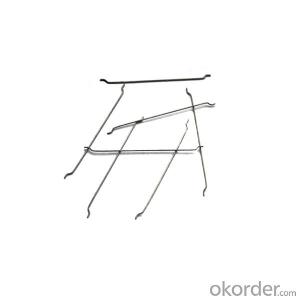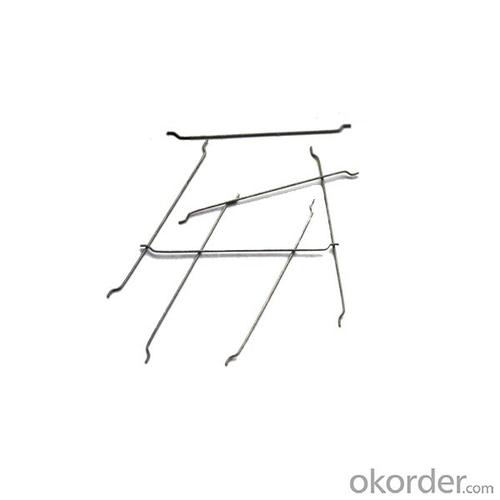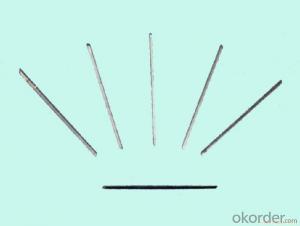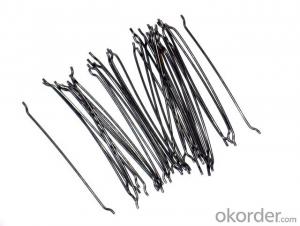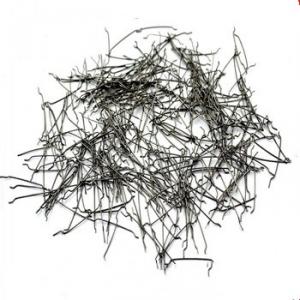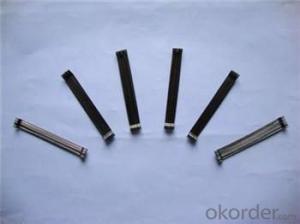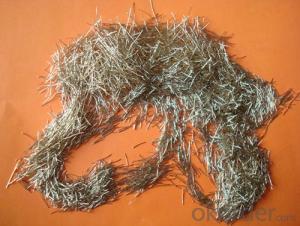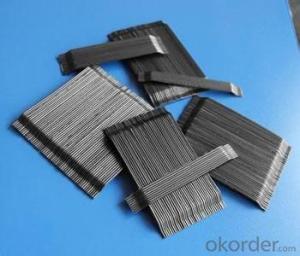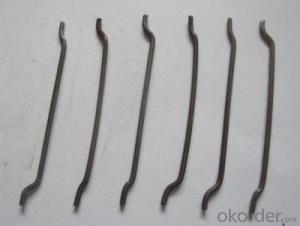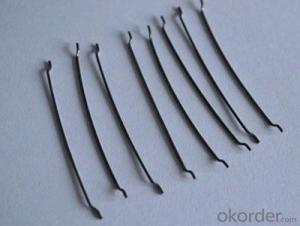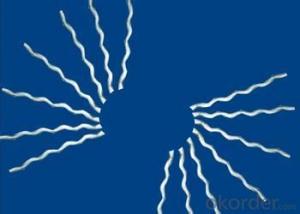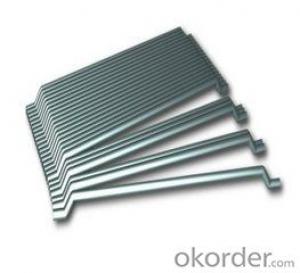Melt Extract Stainless Steel Fiber for High Quality Concrete Reinforcement
- Loading Port:
- Tianjin
- Payment Terms:
- TT OR LC
- Min Order Qty:
- 1 m.t.
- Supply Capability:
- 600 m.t./month
OKorder Service Pledge
Quality Product, Order Online Tracking, Timely Delivery
OKorder Financial Service
Credit Rating, Credit Services, Credit Purchasing
You Might Also Like
Quick Details
Place of Origin: Tianjin, China (Mainland)
- Model Number: 0.75
Material: Steel
Production Process: Cold drawn
Fiber Lengh: 60
Type: 1
Compressive Strength: >1200MPa
Aspect ratio: 80
Standard: ASTM A820M-11
Section Shape: Circular
Application: Concrete Reinforcement
- Product application: Floor
Packaging & Delivery
| Packaging Details: | 20 kg/Bag,50 bags/Pallet or 1,000kg/ Bulk Bag |
|---|---|
| Delivery Detail: | 1 Month |
Product Description
| Diameter | 0.75 | mm | 0.03 | in |
| Length | 60.00 | mm | 2.35 | in |
| Aspect Ratio | 80 | |||
| Tensile strength | 1200 MPa | |||
| Type | Cold drawn Steel Fiber | |||
| End | Hooked-end Steel Fiber | |||
| Glued/Loose | Glued Steel Fiber | |||
| Bending Angle | 45°(min.30°) | |||
| Usage & Performance | Floor:Trafficked areas and Industrial floors | |||
| Shotcrete :Slope stabilization and Final lining | ||||
| Precast concrete:Pipe and Railway sleepers | ||||
| Packing | Standard Export Pallet Packing | Bag Packing | 20 kg/Bag,50 bags/Pallet | |
| Bulk Packing | 1,000kg/ Bulk Bag | |||
| Loading Quantity | 20’GP | 20-25 Tonne/Tonnes | ||
| 40’GP | 25-27 Tonne/Tonnes | |||
| 40’HQ | 25-27 Tonne/Tonnes | |||
| MOQ | 1 kg for trial order | |||
| Supply Ability | 10,000 Tonne/Tonnes per Year | |||
| Payment Terms | T/T or L/C at sight | |||
| Delivery Time | Within 15 days after receiving deposit or original L/C at sight | |||
| Certification | ISO9001:2000, CE, | |||

| Product | Diameter | Length mm/in | Aspect Ratio | Type | Packing |
| G-6030 | 0.5 mm (0.0197 in) | 30 mm (1.1811 in) | 60 | Glued | 20 kg/Bag, or 1,000kg/ Bulk Bag |
| G-6535 | 0.55 mm (0.0217 in) | 35 mm (1.3780 in) | 65 | Glued | 20 kg/Bag, or 1,000kg/ Bulk Bag |
| G-6035 | 0.6 mm (0.0236 in) | 35 mm (1.3780 in) | 60 | Glued | 20 kg/Bag, or 1,000kg/ Bulk Bag |
| G-8060 | 0.75 mm (0.0295 in) | 60 mm (2.3622 in) | 80 | Glued | 20 kg/Bag, 50 bags/Pallet |
| G-6060 | 0.9 mm (0.0354 in) | 60 mm (2.3622 in) | 60 | Glued | 20 kg/Bag, 50 bags/Pallet |
| G-6030 | 0.5 mm (0.0197 in) | 30 mm (1.1811 in) | 60 | Loose | 20 kg/Bag, or 1,000kg/ Bulk Bag |
| G-6535 | 0.55 mm (0.0217 in) | 35 mm (1.3780 in) | 65 | Loose | 20 kg/Bag, or 1,000kg/ Bulk Bag |
| G-6035 | 0.6 mm (0.0236 in) | 35 mm (1.3780 in) | 60 | Loose | 20 kg/Bag, or 1,000kg/ Bulk Bag |
| G-8060 | 0.75 mm (0.0295 in) | 60 mm (2.3622 in) | 80 | Loose | 20 kg/Bag, 50 bags/Pallet |
| G-6060 | 0.9 mm (0.0354 in) | 60 mm (2.3622 in) | 60 | Loose | 20 kg/Bag, 50 bags/Pallet |
- Q: How does melt extract stainless steel fiber improve the crack resistance of concrete?
- Melt extract stainless steel fiber improves the crack resistance of concrete through several mechanisms. Firstly, the addition of stainless steel fibers in the concrete mix helps to distribute the stresses more evenly throughout the entire structure. By forming a three-dimensional network within the concrete, the fibers act as reinforcement, preventing the propagation of cracks and distributing the applied loads more efficiently. Additionally, the high tensile strength and ductility of stainless steel fibers contribute to the crack resistance of concrete. These fibers possess excellent mechanical properties, which allow them to absorb and dissipate energy when subjected to external forces or thermal expansion/contraction. As a result, they provide enhanced resistance to cracking caused by shrinkage, temperature changes, or external loads. Another crucial aspect is the ability of stainless steel fibers to control crack width and limit crack propagation. The fibers act as tiny bridges across the cracks, reducing their width and preventing them from widening further. This restriction of crack width helps to maintain the integrity of the concrete structure, ensuring its durability and longevity. Furthermore, stainless steel fibers also enhance the flexural strength and toughness of concrete. This improved flexural performance allows the concrete to withstand greater bending stresses and deformations without cracking. Consequently, it enhances the overall crack resistance of the concrete, making it more resistant to both initial cracking and further cracking under load. Overall, the addition of melt extract stainless steel fiber to concrete significantly improves its crack resistance by providing a reinforcing network, absorbing energy, controlling crack width, and enhancing flexural strength and toughness. These combined effects result in a more durable and reliable concrete structure, with reduced cracking and increased resistance to various external factors.
- Q: Can melt extract stainless steel fiber be used in architectural precast elements?
- Yes, melt extract stainless steel fiber can be used in architectural precast elements.
- Q: What is the effect of melt extract stainless steel fiber on the modulus of toughness of concrete?
- The addition of melt extract stainless steel fiber to concrete has a positive effect on the modulus of toughness. Stainless steel fibers are known for their high tensile strength and ductility, which helps to enhance the overall toughness of the concrete. When these fibers are dispersed throughout the concrete matrix, they act as reinforcement, improving its resistance to cracking and increasing its ability to withstand impact and cyclic loading. The melt extract stainless steel fibers enhance the bridging effect within the concrete, effectively distributing tensile stresses and preventing the propagation of cracks. This results in a higher energy absorption capacity and improved resistance to crack formation and propagation. As a result, the modulus of toughness of the concrete is significantly increased. Moreover, the addition of stainless steel fibers can also improve the durability of concrete by reducing the risk of corrosion and increasing its resistance to extreme temperatures and chemical attacks. This further contributes to the overall enhancement of the modulus of toughness. In conclusion, the incorporation of melt extract stainless steel fiber in concrete positively affects the modulus of toughness by increasing its resistance to cracking, improving energy absorption capacity, and enhancing its overall durability.
- Q: What is the effect of melt extract stainless steel fiber on the modulus of rupture of shotcrete?
- The modulus of rupture can be significantly affected by the addition of melt extract stainless steel fiber in shotcrete. This term refers to the maximum stress a material can endure before failing in a bending or tensile test. By incorporating stainless steel fibers into shotcrete, its tensile strength and flexural performance are improved, thereby enhancing the modulus of rupture. These fibers act as reinforcement within the shotcrete matrix, improving its overall mechanical properties. The distribution of stresses within the shotcrete is more uniform thanks to the presence of stainless steel fibers, which helps prevent the formation and spread of cracks. Consequently, the modulus of rupture is higher, allowing the shotcrete to withstand greater bending and tensile forces without failure. Moreover, the inclusion of stainless steel fibers also enhances the ductility of shotcrete. Ductility refers to a material's ability to deform plastically before ultimate failure. The fibers create a bridge-like effect, enabling the shotcrete to deform and absorb energy before reaching its breaking point. This increased ductility further contributes to the improvement in the modulus of rupture. In conclusion, the addition of melt extract stainless steel fiber in shotcrete positively impacts the modulus of rupture. It enhances the material's tensile strength, flexural performance, and ductility, resulting in a higher resistance to bending and tensile forces. Consequently, shotcrete with stainless steel fibers becomes a highly durable and reliable construction material, particularly suitable for applications requiring high strength and structural integrity.
- Q: What is the recommended fiber length for melt extract stainless steel fiber in concrete?
- The fiber length for melt extract stainless steel fiber in concrete is typically recommended to be between 25mm and 50mm. This particular fiber length is considered optimal for enhancing the mechanical properties and durability of concrete. It contributes to the improvement of tensile strength, flexural strength, and impact resistance, resulting in a concrete that is less prone to cracking and performs better overall. Moreover, this fiber length ensures that the fibers are properly dispersed and distributed throughout the concrete matrix, resulting in a more uniform reinforcement throughout the structure. However, it is important to acknowledge that the specific fiber length may vary depending on the application and design requirements. Therefore, it is advisable to consult with a structural engineer or refer to the manufacturer's guidelines for accurate recommendations.
- Q: Can melt extract stainless steel fiber be used in lightweight or low-density concrete?
- Yes, melt extract stainless steel fiber can be used in lightweight or low-density concrete. The addition of stainless steel fibers to concrete offers several benefits. Firstly, it improves the overall strength and durability of the concrete, making it more resistant to cracking and shrinkage. The fibers also enhance the concrete's resistance to impact and abrasion, making it suitable for applications where the concrete may be subjected to heavy loads or wear. In lightweight or low-density concrete, the stainless steel fibers help to reinforce and stabilize the material. The fibers distribute the stress and load throughout the concrete, preventing the formation of cracks and improving its structural integrity. Additionally, the stainless steel fibers can help to control shrinkage and reduce the risk of cracking, which is especially important in low-density concrete where shrinkage can be more pronounced. Moreover, melt extract stainless steel fibers are corrosion-resistant, making them suitable for use in concrete exposed to harsh environmental conditions or in applications where the concrete is in contact with corrosive substances. This corrosion resistance ensures that the fibers will maintain their strength and performance over time. Overall, the addition of melt extract stainless steel fiber to lightweight or low-density concrete can enhance its mechanical properties, improve its durability, and provide better resistance to cracking and shrinkage.
- Q: What is the effect of melt extract stainless steel fiber on the shear strength of concrete beams?
- The impact of melt extract stainless steel fiber on the shear strength of concrete beams generally yields positive results. When incorporated into concrete, stainless steel fibers act as reinforcement by enhancing both tensile and flexural strength. This reinforcement mechanism effectively prevents crack propagation and enhances the concrete's ductility and toughness. Regarding shear strength, the inclusion of melt extract stainless steel fibers in concrete beams significantly boosts their resistance against shear forces. These fibers improve the cohesion between the concrete matrix and aggregates, resulting in enhanced interlocking and shear transfer mechanisms. Consequently, the concrete beams exhibit increased resistance to shear failure and overall structural integrity. Furthermore, the presence of stainless steel fibers minimizes the formation and propagation of microcracks caused by shear stresses in the concrete. By limiting crack formation, the fibers contribute to maintaining the continuity and stability of the concrete beams, thereby enhancing their shear strength. In addition, the aspect ratio (length to diameter ratio) of the stainless steel fibers plays a vital role in their impact on shear strength. Longer fibers with higher aspect ratios offer superior reinforcement and improve the shear strength of concrete beams compared to shorter fibers. It is crucial to carefully determine the optimal dosage and distribution of stainless steel fibers based on the specific requirements and design considerations of the concrete beams. Factors such as fiber length, diameter, volume fraction, and concrete mix proportions should be taken into account to achieve the desired improvement in shear strength while ensuring the overall performance and durability of the concrete structure.
- Q: What is the recommended testing procedure for melt extract stainless steel fiber in concrete?
- The recommended testing procedure for melt extract stainless steel fiber in concrete typically involves conducting a series of tests to evaluate its performance and compatibility. This may include evaluating the fiber's physical properties, such as diameter, length, and aspect ratio, through microscopic analysis. Additionally, assessing the fiber's tensile strength, corrosion resistance, and bond strength with concrete is crucial. Various standardized tests, such as ASTM C1550 and ASTM C1609, can be employed to determine these characteristics. Lastly, it is important to conduct field trials to observe the fiber's performance in real-world conditions and ensure its suitability for the intended application.
- Q: Can melt extract stainless steel fiber be used in airport runways?
- Yes, melt extract stainless steel fiber can be used in airport runways. The high strength and durability of stainless steel make it suitable for heavy-duty applications like airport runways, where it can enhance the strength and resistance to cracking and rutting of the pavement. Stainless steel fibers can also improve the overall lifespan and performance of airport runways by providing reinforcement and reducing maintenance needs.
- Q: How does melt extract stainless steel fiber enhance the crack resistance of concrete?
- Melt extract stainless steel fiber enhances the crack resistance of concrete through several mechanisms. Firstly, the addition of stainless steel fibers to the concrete mix increases its tensile strength. This means that the concrete is better able to resist the forces that cause cracking, such as shrinkage, temperature changes, and external loads. The fibers help to distribute these forces more evenly throughout the concrete, reducing the likelihood of cracks forming. Secondly, stainless steel fibers act as reinforcement within the concrete matrix. When cracks do occur, the fibers help to hold the concrete together and prevent the cracks from propagating further. This improves the overall durability and longevity of the concrete structure. Furthermore, melt extract stainless steel fibers also enhance the impact resistance of concrete. The fibers absorb and distribute the energy from impacts, reducing the likelihood of cracks forming or propagating due to sudden loading. Additionally, stainless steel fibers can also improve the resistance of concrete to chemical attack. They provide a physical barrier that inhibits the penetration of aggressive chemicals, such as chlorides or sulfates, into the concrete. This helps to prevent the deterioration of the concrete and reduces the risk of cracks forming due to chemical exposure. Overall, melt extract stainless steel fiber enhances the crack resistance of concrete by improving its tensile strength, reinforcing the concrete matrix, increasing its impact resistance, and providing a barrier against chemical attack. These combined effects result in a more durable and crack-resistant concrete structure.
Send your message to us
Melt Extract Stainless Steel Fiber for High Quality Concrete Reinforcement
- Loading Port:
- Tianjin
- Payment Terms:
- TT OR LC
- Min Order Qty:
- 1 m.t.
- Supply Capability:
- 600 m.t./month
OKorder Service Pledge
Quality Product, Order Online Tracking, Timely Delivery
OKorder Financial Service
Credit Rating, Credit Services, Credit Purchasing
Similar products
Hot products
Hot Searches
Related keywords
